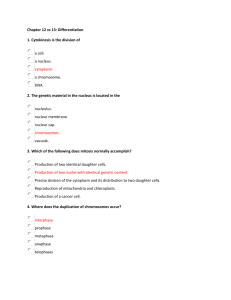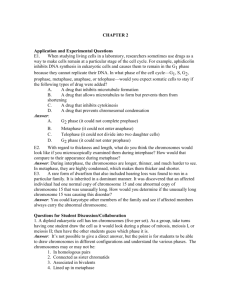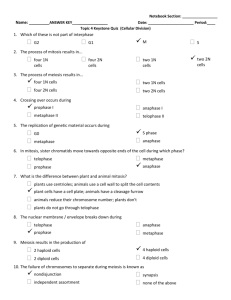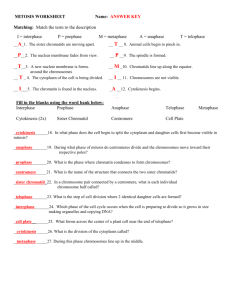File - Biology with Radjewski
advertisement
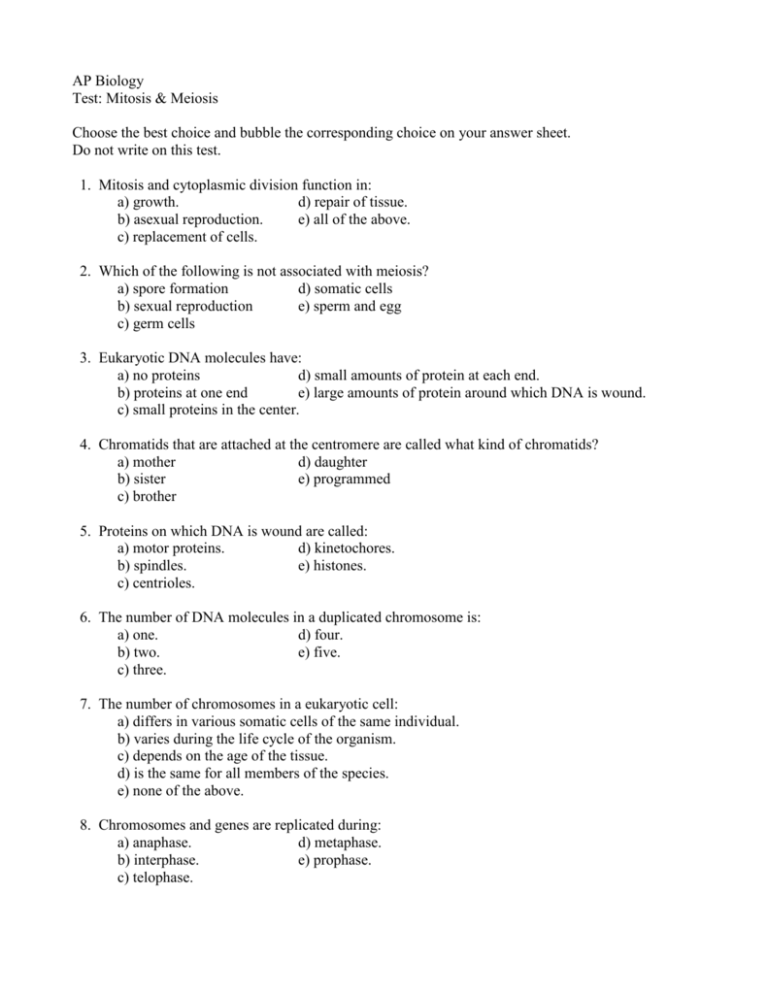
AP Biology Test: Mitosis & Meiosis Choose the best choice and bubble the corresponding choice on your answer sheet. Do not write on this test. 1. Mitosis and cytoplasmic division function in: a) growth. d) repair of tissue. b) asexual reproduction. e) all of the above. c) replacement of cells. 2. Which of the following is not associated with meiosis? a) spore formation d) somatic cells b) sexual reproduction e) sperm and egg c) germ cells 3. Eukaryotic DNA molecules have: a) no proteins d) small amounts of protein at each end. b) proteins at one end e) large amounts of protein around which DNA is wound. c) small proteins in the center. 4. Chromatids that are attached at the centromere are called what kind of chromatids? a) mother d) daughter b) sister e) programmed c) brother 5. Proteins on which DNA is wound are called: a) motor proteins. d) kinetochores. b) spindles. e) histones. c) centrioles. 6. The number of DNA molecules in a duplicated chromosome is: a) one. d) four. b) two. e) five. c) three. 7. The number of chromosomes in a eukaryotic cell: a) differs in various somatic cells of the same individual. b) varies during the life cycle of the organism. c) depends on the age of the tissue. d) is the same for all members of the species. e) none of the above. 8. Chromosomes and genes are replicated during: a) anaphase. d) metaphase. b) interphase. e) prophase. c) telophase. 9. The interval before the onset of DNA replication is the: a) G1 stage. d) S stage. b) G2 stage. e) M stage. c) mitosis. 10. The stage of the cell cycle just preceding nuclear and cytoplasmic division is the: a) G1 stage. d) S stage. b) G2 stage. e) M stage. c) mitosis. 11. In mitosis, if a parent cell has 16 chromosomes, each daughter cell will have how many chromosomes? a) 64 d) 8 b) 32 e) 4 c) 16 12. Cells with two of each kind of chromosome are described by the term: a) haploid. d) polyploidy. b) diploid. e) none of the above. c) aneuploid. 13. The spindle apparatus is made of: a) Golgi bodies. d) polysaccharides. b) microtubules. e) chromatids. c) nucleotides. 14. The spindle apparatus becomes visible during: a) prophase d) telophase. b) metaphase. e) interphase. c) anaphase. 15. Which of the following is not true of spindles: a) they are permanent structures of the skin. b) they are bipolar c) they are composed of tubulin d) they attach to chromosomes e) all of the above are true. 16. In eukaryotic cells, which can occur during the stages of mitois? a) duplication of chromatids d) replication of DNA b) crossing over e) all of the above. c) break up of nuclear membrane. 17. In which of the following phases does each chromosome consist of two DNA molecules? a) prophase and metaphase d) prophase and telophase b) interphase and telophase e) all phases of mitosis. c) anaphase and telophase. 18. Sister chromatids detach from each other during: a) prophase d) telophase b) metaphase e) interphase. c) anaphase 19. The chromosomes arrive at opposite poles during: a) prophase d) telophase b) metaphase e) interphase. c) anaphase 20. Chromosomes line up at the equator during: a) prophase d) telophase b) metaphase e) interphase. c) anaphase 21. The nuclear membrane reforms during: a) prophase d) telophase b) metaphase e) interphase. c) anaphase 22. The end result of mitosis is: a) four haploid cells b) four diploid cells c) one polyploid cell d) two haploid cells e) none of the above. 23. Cytoplasmic division (cytokinesis): a) differs in plant and animal cells. b) usually accompanies nuclear division c) involves microtubule or actin filaments d) all of the above e) none of the above 24. The uncontrolled division of cells can lead to: a) cancer d) meiosis b) mitosis e) cellular recombination c) synapsis 25. The spread of cancer from one site in the body to another in the body is known as: a) a benign tumor d) remission b) migration e) metastasis c) invasion 26. All of the following are advantages of sexual reproduction, except: a) adaptation to a changing environment b) increase in genetic variation c) energetically costly d) offspring with new traits e) all of the above are advantages. 27. Meiosis can occur in: a) plant ovaries b) plant anther c) human testis d) human ovaries e) all of the above 28. Asexually produced daughter cells are: a) genetically identical d) different from the parents b) same as the parent cell e) both a and b are correct c) different from each other 29. Different or alternate forms of the same gene are called: a) haploid d) diploid b) allele e) chromatid c) zygote 30. Having two copies of each type of chromosome is called: a) haploid d) diploid b) allele e) chromatid c) zygote 31. Having only one copy of each type of chromosome is called: a) haploid d) diploid b) allele e) chromatid c) zygote 32. The process of going from a diploid cell to a haploid cell occurs during: a) replication d) interphase b) meiosis e) anaphase c) mitosis 33. Chromosomes that have the same type of genes in the same locations are called: a) chromotids. d) chromatin. b) dihybrids e) homologues c) recombinant 34. Crossing over occurs during: a) prophase I b) metaphase II c) anaphase I d) anaphase II e) prophase II 35. Crossing over is important because it can lead to: a) a sex change d) a new national allegiance b) identical daughter cells e) none of the above c) tissue repair 36. Crossing over involves: a) alignment of homologous pairs b) formation of a tetrad c) synapsis d) chiasma e) all of the above 37. In a developing sperm cell at the beginning of prophase I, there are how many molecules of DNA? a) 23 d) 46 b) 92 e) 11.5 c) 115 38. If a child more resembles one parent’s traits it could be explained from the movement of chromosomes during: a) prophase I d) anaphase II b) metaphase II e) prophase II c) anaphase I 39. If a diploid organism has 4 pairs of chromosomes it can produce how many different combinations of maternal and paternal chromosomes (disregarding crossing over): a) 4 d) 16 b) 8 e) 32 c) 12 40. The random alignment of chromosomes at the equator during meiosis is referred to as: a) independent assortment d) centrosomation b) linked assortment e) crossing over c) equatorial delineation. 41. During oogenesis an unequal sharing of cytoplasm during cytokinesis leads to the formation of a) one ovum d) all of the above. b) three polar bodies e) none of the above c) less eggs than sperm 42. Circular DNA, lack of a nucleus and no chromosomes are characteristics of: a) plants d) fungi b) animals e) prokaryotes c) eukaryotes 43. A multicellular haploid stage can be found in many: a) bacteria d) humans b) plants e) all of the above c) prokaryotes 44. Meiosis leads to the formation of sex cells or: a) identical daughter cells d) gametes b) chromatids e) zygotes c) somatic cells 45. The union of a male sperm with a female egg is called: a) trouble d) spermatogenesis b) oogenesis e) fertilization c) mitosis 46. When chromosomes fail to separate equally during meiosis it is called: a) nondisjunction d) spindilation b) allopatriation e) nondisclosure c) synapsis 47. Trisomy 21 is an example of: a) an extra chromosome b) nondisjunction c) a problem with meiosis d) all of the above e) none of the above 48. Nondisjunction during meiosis I can lead to: a) four viable, good gametes d) two complete daughter cells b) four mutant gametes e) all of the above c) 2 bad, 2 good gametes 49. Spermatogenesis produces: a) one sperm b) three polar bodies c) two viable sperm d) all of the above. e) none of the above 50. Fertilization of plant gametes produces a: a) spore d) haploid cell b) gametophyte e) zygote c) multicellular haploid plant. Answers: 1. E 2. D 3. E (histones 4. B 5. E 6. B 7. D 8. B 9. A 10. B 11. C 12. B 13. B 14. A 15. A 16. C 17. A 18. D 19. D 20. B 21. D 22. E 23. D 24. A 25. Skip 26. E 27. E 28. E 29. B 30. D 31. A 32. B 33. E 34. A 35. E 36. E 37. D 38. A 39. D 40. A 41. D 42. E 43. B 44. D 45. E 46. Skip 47. Skip 48. Skip 49. E 50. B




